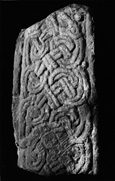Select a site alphabetically from the choices shown in the box below. Alternatively, browse sculptural examples using the Forward/Back buttons.
Chapters for this volume, along with copies of original in-text images, are available here.
Object type: Part of cross-shaft, in two pieces
Measurements:
a (upper): H. 59 cm (23.25 in); W. 33 > 28 cm (13 > 11 in); D. 14 > 13 cm (5.5 > 5 in)
b (lower): H. 61 cm (24 in); W. 35 > 34.5 cm (13.75 > 13.5 in); D. 16 > 14 cm (6.25 > 5.5 in)
Stone type: Medium-grained red sandstone (St Bees sandstone)
Plate numbers in printed volume: 60 - 7
Corpus volume reference: Vol 2 p. 58
(There may be more views or larger images available for this item. Click on the thumbnail image to view.)
The two fragments are closely adjacent parts of the same slab-like cross-shaft. No panelling division survives on any face and all sides are bordered by a roll moulding. At the bottom of the lower fragment, b, is an undecorated strip, c. 16 cm (6.25 in) deep, which was presumably sunk into a socket or direct into the ground.
A (broad): Interlace, a form of complete turned pattern A, badly laid out and using median-incised strands; pellets are dispersed around and within the motif. The intersections of the knots are marked by drilled holes. In the upper right corner one strand terminates in an animal's head with two large jaws which sweep round the back of the large round eye.
B (narrow): Interlace with free rings and long diagonals, using median-incised strands; the intersections are marked by drilled holes.
C (broad): The upper fragment, a, carries the worn remains of interlace, probably a form of half pattern F with outside strand. On the lower fragment, b, is a form of ring-knot whose 'tie' is lozenge-shaped. The strands are median-incised and pellets are interspersed; a curling extension springs from each turn of the strands.
D (narrow): Three-strand plain plait; the strands are median-incised and the hole points are drilled.
Beckermet school (Introduction, pp. 38–40). Though work of the Beckermet school is most readily distinguished by the use of runs of simple pattern E, there is no doubt that this shaft can nevertheless be assigned to the group. On face C of fragment a is a form of interlace which otherwise only occurs on Beckermet St John 4, 5, (probably) 6, and on Workington 4 – all products of this school. Other carvings from the group offer close parallels for further details: Beckermet St John 4 for the peculiar form of ring-knot; nos. 4 and 5 from this site for the zoomorphic heads; Brigham 2 for the drilled emphasis.
Ring-knots are a popular element in Viking-age sculpture. Popular also in the art of Scandinavia and the colonies are lozenge-shaped 'ties', whilst lobate extensions to interlace and zoomorphic ornament have a long history in Scandinavian and English art. There is therefore no need to assume that the knot on face C of fragment b should necessarily be interpreted as a reflex of Viking-age sculpture on Man (pace Shetelig 1948, 75) particularly since the combination of lozenge and ring-knot does not occur on the island. The argument seems even less convincing now that this combination can be shown in sculpture from both York and Chester and, in other media, from England, Ireland, Iceland, and Scandinavia (Bu'lock 1958, fig. 3; Waterman 1959, fig. 15 no. 2; Raftery 1941, pl. 98c; Petersen 1928, fig. 227; Wilson and Klindt-Jensen 1980, pl. XXVII f). Before rejecting all possibility of links to the Isle of Man however, it should be noted that the trilobed extension to the ring-knot on the associated Beckermet St John 4 does seem to be Manx-derived.



